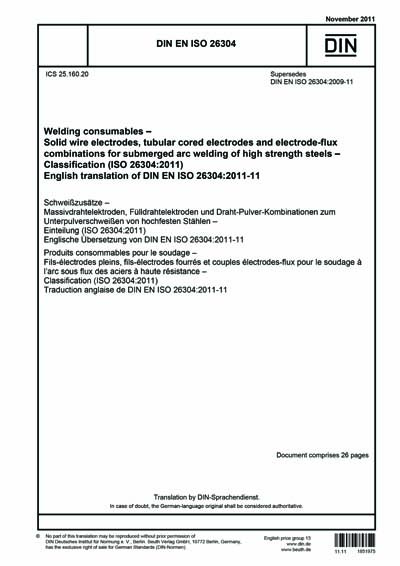Historical
DIN EN ISO 26304:2011
Welding consumables - Solid wire electrodes, tubular cored electrodes and electrode-flux combinations for submerged arc welding of high strength steels - Classification (ISO 26304:2011); German version EN ISO 26304:2011
This International Standard specifies requirements for classification of solid wire electrodes, tubular cored electrodes, and electrode-flux combinations (the all-weld metal deposits) in the as-welded condition and in the post-weld heat-treated condition for submerged arc welding of high strength steels with a minimum yield strength greater than 500 MPa or a minimum tensile strength greater than 570 MPa. One flux can be tested and classified with different electrodes. One electrode can be tested and classified with different fluxes. The solid wire electrode is also classified separately based on its chemical composition. This International Standard is a combined specification providing for classification utilizing a system based upon the yield strength and average impact energy of 47 J for the all-weld metal, or utilizing a system based upon the tensile strength and average impact energy of 27 J for the all-weld metal. a) Clauses, subclauses and tables which carry the suffix letter "A" are applicable only to solid wire electrodes, tubular cored electrodes and the all-weld metal deposits classified to the system based upon the yield strength and the average impact energy of 47 J for the all-weld metal obtained with electrode-flux combinations in accordance with this International Standard. b) Clauses, subclauses and tables which carry the suffix letter "B" are applicable only to solid wire electrodes, tubular cored electrodes and the all-weld metal deposits classified to the system based upon the tensile strength and the average impact energy of 27 J for the all-weld metal obtained with electrode-flux combinations in accordance with this International Standard. c) Clauses, subclauses and tables which do not have either the suffix letter "A" or the suffix letter "B" are applicable to all solid wire electrodes, tubular cored electrodes and electrode-flux combinations classified in accordance with this International Standard. For comparison purposes, some tables include requirements for electrodes classified in accordance with both systems, placing individual electrodes from the two systems, which are similar in composition and properties, on adjacent lines in the particular table. In a particular line of the table that is mandatory in one system, the symbol for the similar electrode from the other system is indicated in parentheses. By appropriate restriction of the formulation of a particular electrode, it is often, but not always, possible to produce an electrode that can be classified in both systems, in which case the electrode, or its packaging, may be marked with the classification in either or both systems.*This standard specifies requirements for classification of solid wire electrodes, tubular cored electrodes, and electrode-flux combinations (the all-weld metal deposits) in the as-welded condition and in the post-weld heat-treated condition for submerged arc welding of high strength steels with a minimum yield strength greater than 500 MPa or a minimum tensile strength greater than 570 MPa. One flux can be tested and classified with different electrodes. One electrode can be tested and classified with different fluxes. The solid wire electrode is also classified separately based on its chemical composition. The International Standard has been prepared by applying the cohabitation principle, that means, two approaches, subdivided into A and B, are specified for the same subject to be standardized. Approach A mainly reflects the European specifications; approach B mainly reflects the specifications in the Pacific Rim. It shall be noted that it shall be specified according to which approach (A or B) products shall be manufactured orsupplied. This standard contains a combined specification providing for classification utilizing a system based upon the yield strength and average impact energy of 47 J for the all-weld metal, or utilizing a system based upon the tensile strength and average impact energy of 27 J for the all-weld metal. With respect to the previous document, the specifications relating to the test pieces have been subdivided into A-side and B-side. The underlying International Standard ISO 26304:2011 has been prepared by ISO/TC 44/SC 3 "Welding consumables", the secretariat of which is held by ANSI (USA) and has been adopted identically as a European draft standard by CEN/TC 121 "Welding" (secretariat: DIN). The responsible German standardization committee is Working Committee NA 092-00-03 AA "Schweißzusätze (DVS AG W 5)" ("Welding consumables (DVS AG W 5)") at NAS.
Deutsches Institut für Normung [din]

